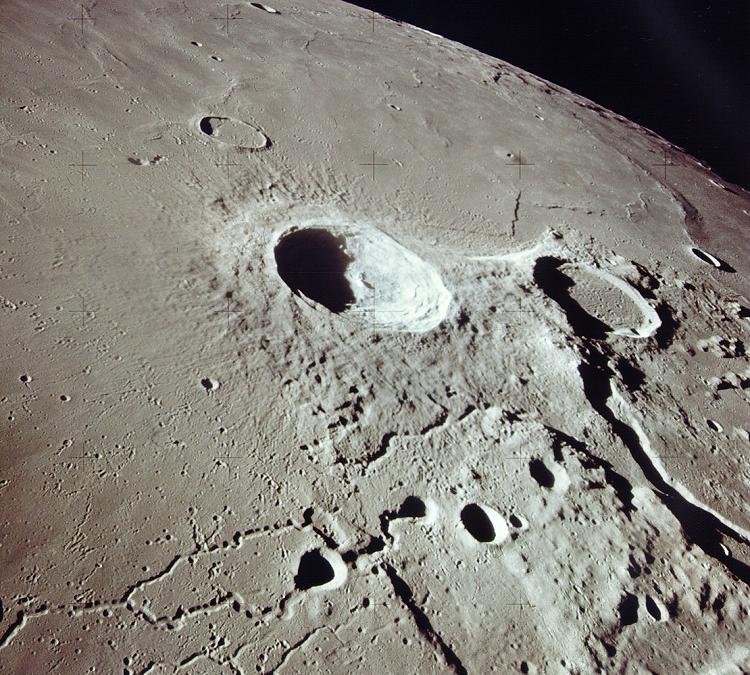 |
| "Aristarchus and Herodotus craters Apollo 15". Licensed under Public Domain via Commons - Wikimedia |
Aristarchus Crater
Aristarchus, named after the Greek astronomer Aristarchus of Samos, is a prominent lunar impact crater that lies in the northwest part of the Moon's near side. It is considered the brightest of the large formations on the lunar surface, with an albedo nearly double that of most lunar features. The feature is bright enough to be visible to the naked eye, and is dazzling in a large telescope. It is also readily identified when most of the lunar surface is illuminated by earthshine.
Aristarchus is located on an elevated rocky rise, known as the Aristarchus Plateau, in the midst of the Oceanus Procellarum, a large expanse of lunar mare. This is a tilted crustal block, about 200 km across, that rises to a maximum elevation of 2 km above the mare in the southeastern section. Aristarchus is just to the east of the crater Herodotus and the Vallis Schröteri, and south of a system of narrow sinuous rilles named Rimae Aristarchus.
Aristarchus is bright because it is a young formation, approximately 450 million years old, and the solar wind has not yet had time to darken the excavated material by the process of space weathering. The impact occurred following the creation of the ray crater Copernicus, but before the appearance of Tycho. Due to its prominent rays, Aristarchus is mapped as part of the Copernican System.
"The Aristarchus plateau is one of the most geologically diverse places on the moon: a mysterious raised flat plateau, a giant rille carved by enormous outpourings of lava, fields of explosive volcanic ash, and all surrounded by massive flood basalts," said Mark Robinson, principal investigator of the Lunar Reconnaissance Orbiter Camera at Arizona State University. NASA released photos of the crater on December 25, 2011.
Wikipedia
Aristarchus of Samos
The crater is remarkable and so is Aristarchus of Samos after whom it was named by Giovanni Riccioli in 1651. For Aristarchus is the first known human who suggests a heliocentric world view instead of the geocentric one prevalent in the world until Copernicus changed it all. Also the world view of all Biblical writers is firmly geocentric.
Aristarchus of Samos (Greek: Ἀρίσταρχος Aristarkhos; c. 310 – c. 230 BC) was an ancient Greek astronomer and mathematician who presented the first known model that placed the Sun at the center of the known universe with the Earth revolving around it. He was influenced by Philolaus of Croton, but he identified the "central fire" with the Sun, and put the other planets in their correct order of distance around the Sun. As Anaxagoras before him, he also suspected that the stars were just other bodies like the sun. His astronomical ideas were often rejected in favor of the geocentric theories of Aristotle and Ptolemy.
Wikipedia
The crucial text
Though the original text has been lost, a reference in Archimedes' book The Sand Reckoner (Archimedis Syracusani Arenarius & Dimensio Circuli) describes a work by Aristarchus in which he advanced the heliocentric model as an alternative hypothesis to geocentrism. Archimedes wrote:
You (King Gelon) are aware the 'universe' is the name given by most astronomers to the sphere the center of which is the center of the Earth, while its radius is equal to the straight line between the center of the Sun and the center of the Earth. This is the common account as you have heard from astronomers. But Aristarchus has brought out a book consisting of certain hypotheses, wherein it appears, as a consequence of the assumptions made, that the universe is many times greater than the 'universe' just mentioned. His hypotheses are that the fixed stars and the Sun remain unmoved, that the Earth revolves about the Sun on the circumference of a circle, the Sun lying in the middle of the Floor, and that the sphere of the fixed stars, situated about the same center as the Sun, is so great that the circle in which he supposes the Earth to revolve bears such a proportion to the distance of the fixed stars as the center of the sphere bears to its surface.
— The Sand Reckoner
Aristarchus suspected the stars were other suns that are very far away, and that in consequence there was no observable parallax, that is, a movement of the stars relative to each other as the Earth moves around the Sun. Since stellar parallax is only detectable with telescopes, his speculation although accurate was unprovable at the time.
Wikipedia
Distances to sun and moon
 |
| Aristarchus's 3rd-century BC calculations on the relative sizes of (from left) the Sun, Earth and Moon, from a 10th-century AD Greek copy. "Aristarchus working". Licensed under Public Domain via Commons - Wikimedia |
The only surviving work usually attributed to Aristarchus, On the Sizes and Distances of the Sun and Moon, is based on a geocentric world view. It has historically been read as stating that the angle subtended by the Sun's diameter is 2 degrees, but Archimedes states in The Sand Reckoner that Aristarchus had a value of ½ degree, which is much closer to the actual average value of 32' or 0.53 degrees. The discrepancy may come from a misinterpretation of what unit of measure was meant by a certain Greek term in Aristarchus' text
Using correct geometry, but the insufficiently accurate 87° datum, Aristarchus concluded that the Sun was between 18 and 20 times farther away than the Moon. (The true value of this angle is close to 89° 50', and the Sun's distance is actually about 400 times the Moon's.)
Wikipedia
_____
Excerpts from Wiki texts have been incorporated into the blog as kinds of abstracts for reader's convenience. By clicking the links much more can be learned about these subjects.
No comments:
Post a Comment